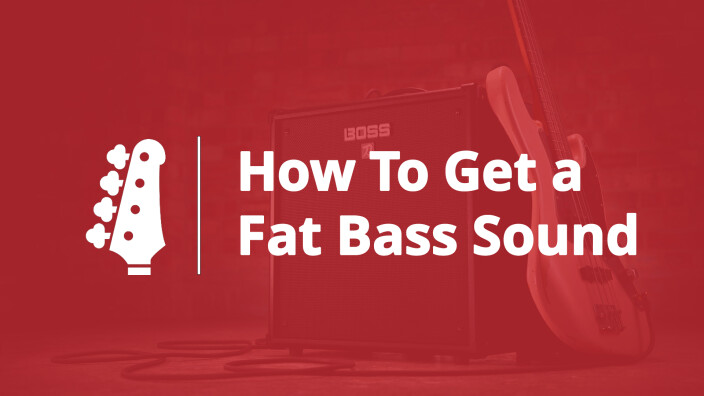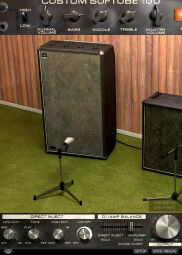Just like an electric guitar, an electric bass can also sound big — but the way to get that sound is not the same.

Responsible, together with the drums, of the rhythmic foundations of a song, the bass guitar as an instrument must be perfect in terms of timing. Unlike guitars, it’s very rare that a bass guitar is doubled or quadrupled during production. Why? Because even with the most accurate player, it produces a huge bass sound but also leads to a loss in precision, which isn’t the best for the rhythmic foundations of the song.
DI yourself
As a consequence, and to avoid having an imprecise groove, bass guitars are generally recorded and mixed with a lot of soberness. In many songs, the bass is recorded with a DI (Direct Injection) box, the DI output of the amp or directly into the mixing desk, heavily compressed, maybe EQed if necessary, and that’s it!
Why compression? For two main reasons: to control the high dynamic range of the recording (all the more when the bass is slapped) and to ensure that the bass guitar is present throughout the whole song. In fact, compressing the bass track is so common in some music genres (rock, funk, etc.) that many bass amps are equipped with an internal compressor.
Check out the results with the following dry take, then the same recording compressed with a Fairchild 670 emulation (a quite expensive compressor with a strong character):

- slapDI 00:06
- slapDIcomp 00:06
And that’s it? Yes. In many cases, that’s all you’ll have to do and it will be enough to get a big bass sound. However, the sound is desperately clean, and maybe you want a sound with a bit more crunch…
The best of both worlds
You can easily get such a sound by recording the bass amp directly, instead of going through a DI. Properly captured with a good-quality microphone, a bass amp brings the “wosh” effect that is missing in the DI sound (a fatness that makes you move your feet) along with more grain and personality.
You have no bass amp or a suiting microphone? Don’t worry, you can use a hardware or software bass amp simulation.
Listen to our DI bass recording processed with a Guitar Rig Pro 5 bass preset:

- bassDI 00:16
- bassAMP 00:16
But there is a problem: while this solution enhances the bottom-end, the high-frequency range tends to suffer with some bass amps, which means the attack loses definition. So, does this mean that the ultimate bass sound is a mix of a DI signal and an amp one?
This is exactly the solution chosen by most sound engineers when dealing with a bass guitar: they mix a track with the DI sound (which is interesting for its clarity and perfectly defined attacks) with a bass-amp track to add personality and fullness to the cold DI sound. But watch out: the goal is not to double the instrument, which implies that the bass player must record his part twice, the goal is rather to mix two tracks of the same recording.
Listen to the result with the DI sound first, then the amp sound, and finally the mix of both:

- bassDI 00:16
- bassAMP 00:16
- bassDIplusAMP 00:16
Interesting, isn’t it? All the more considering the nuances that the balance between both tracks provides…
to balance the direct sound and the amplified sound using a single track. However, to have more processing possibilities I recommend you to put each sound in its own track, just by duplicating the DI track in your sequencer, and inserting an amp simulation into one of them. That way, you will be able to process each signal independently so that they complement each other, for example with EQing.
And that’s it? Well that ought to be enough, but you can explore additional solutions to get a fat sound bass… by checking the possibilities synths provide!
Synths everywhere!
You’re missing bottom-end or fullness in your bass sound? Try to double it with bass synth, even a very simple one (a single sine wave can be enough and even has the advantage of avoiding you issues in the high-frequency range) and your bass sound will come back to life. To achieve this, you can play the bass part note by note with the synth. But you can also use the audio-to-Midi function you’ll find in most pitch editors like Melodyne to make your life easier, even if you have to fine-tune the part in the piano-roll window afterwards.
Depending on the synth sound you chose, you’ll get different colors. The goal is to mix the bass synth part in the background so that it doesn’t draw attention to itself while still serving the bass part. In the following example, you’ll hear the bass part alone, then the bass part with a bass synth in the background.

- Basse seule 00:11
- doublesynth 00:10
You can also try to transpose the bass synth to the next lower octave to get some sub-bass, even if this sort of processing is more easily audible.

For a relatively similar result, you can also send your bass part into an octaver effect, but you have to pay attention to the resulting mix because it can be counterproductive. Be careful, don’t overdo things and don’t hesitate to use an EQ to suppress unpleasant frequencies. Listen to the octaver effect in the following examples. First the DI track, then the same track with an octaver in the background, and finally with the octaver in the foreground, which is not necessarily the best thing to do for the whole bass line:

- octaver off 00:16
- octaver small 00:16
- octaver alot 00:16
Adding low frequencies is nice, but what you’re looking for is perhaps not here. Do you want more grain? A more abrasive tone? Do it: give distortion a try!
Fuss the Bazz!
In the most brutal music genres, distortion is often used on bass guitar. But even if you don’t play death metal or hardcore music, it’s very interesting to send the bass through a saturation effect, even if you mix the latter in the background.
Listen to the following example: it’s the same bass line as above, but it has been sent into a fuzz effect:

Finally, let’s try out a bass line combining DI, synth and fuzz sound. You’ll here two bars of DI bass, then two bars with DI+synth, and finally with DI+synth+fuzz up to the end of the track:

But there are much more obvious examples than such tweaking. To convince yourself, just listen to Muse’s Hysteria (thanks to “2037 marie” for this example) where bass and synth are perfectly matched:
Or listen to this bass line by Gorillaz that is obviously fattened with an octaver effect or a synth playing the bass line on the next lower octave:
For a less obvious but also effective processing, carefully listen to the most famous four-string riff in the intro of Michael Jackson’s Billie Jean. Louis Johnson’s Yamaha electric bass is doubled by Greg Phillinganes’s Rhodes and maybe even by the synth…
Bass conflicts
Now that you now a bit more about how to get a huge bass tone, the time has come for you to decide to either not do it or to do it but keeping in mind how your mix will develop.
In fact, the bass guitar shares most of its frequency range with the bass drum. This means that if you emphasize the bass guitar, you leave less space to the kick, which can become a problem. You can certainly solve the conflict between the two instruments using side-chain compression or EQ, but you’ll have to decide if the bass is either below or above the kick. So the best thing is to avoid overdoing the processing when you produce the bass guitar, or at least to keep the mix in mind so that this processing actually enhances the overall mix (bass + drums, and also all instruments together)… So now you know why on many songs they only use a bass recorded via DI and apply EQ wisely, instead of over-fattening the bass.


